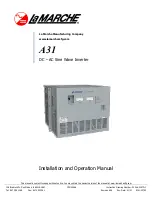
IMPORTANT SAFETY INSTRUCTIONS
2001 Xantrex Technology, Inc.
5916 - 195th Street N. E.
Arlington, WA 98223
Telephone: 360/435-8826
Fax: 360/435-2229
www.traceengineering.com
SW Series Inverter/Charger
Part No. 2031-5
Rev. C: February 2001
Page
3
10. GROUNDING INSTRUCTIONS - This inverter/battery charger should be connected to a grounded,
permanent wiring system. For most installations, the negative battery conductor should be bonded to
the grounding system at one (and only one point) in the system. All installations should comply with
national and local codes and ordinances. Refer to the SYSTEM GROUNDING section on page 26 for
more information.
PERSONAL PRECAUTIONS
1. Someone should be within range of your voice or close enough to come to your aid when you work
near batteries.
2. Have plenty of fresh water and soap nearby in case battery acid contacts skin, clothing, or eyes.
3. Wear complete eye protection and clothing protection. Avoid touching eyes while working near
batteries. Wash your hands when done.
4. If battery acid contacts skin or clothing, wash immediately with soap and water. If acid enters eye,
immediately flood eye with running cool water for at least 15 minutes and get medical attention immediately.
(a) Baking soda neutralizes lead acid battery electrolyte.
(b) Vinegar neutralizes spilled NiCad and NiFe battery electrolyte.
(c) Keep a supply on hand in the area of the batteries.
5. NEVER smoke or allow a spark or flame in vicinity of a battery or generator.
6. Be extra cautious to reduce the risk of dropping a metal tool onto batteries. It could short-circuit the
batteries or other electrical parts that may result in a spark which could cause an explosion.
7. Remove personal metal items such as rings, bracelets, necklaces, and watches when working with a
battery. A battery can produce a short-circuit current high enough to weld a ring or the like to metal,
causing severe burns.
8. NEVER charge a frozen battery.
9. If necessary to remove the battery, make sure all accessories are off. Then, remove the grounded
terminal from the battery first.
10. If a remote or automatic generator
control system
is used, disable the automatic starting circuit and/or
disconnect the generator from its starting battery while performing maintenance to prevent accidental
starting.
11. Provide ventilation to outdoors from the battery compartment. The battery enclosure should be
designed to prevent accumulation and concentration of hydrogen gas in “pockets” at the top of the
compartment. Vent the battery compartment from the highest point. A sloped lid can also be used to
direct the flow to the vent opening location.
12. Clean battery terminals. Be careful to keep corrosion from coming in contact with eyes.
13. Study all the battery manufacturer’s specific precautions, such as removing or not removing cell caps
while charging and recommended rates of charge.
14. For flooded lead acid batteries, add distilled water in each cell until the battery acid reaches the level
specified by the battery manufacturer. This helps purge excessive gas fumes from the cells. Do not
overfill. For a battery without cell caps, carefully follow the manufacturer’s recharging instructions.
Summary of Contents for SW Series
Page 151: ......











































